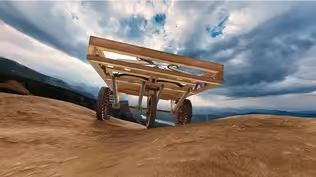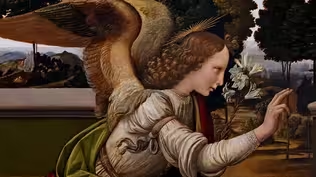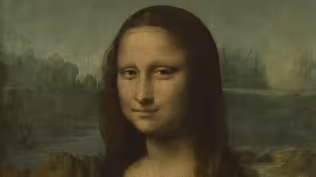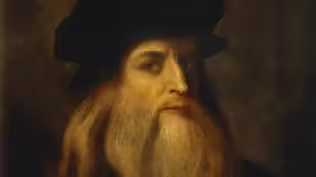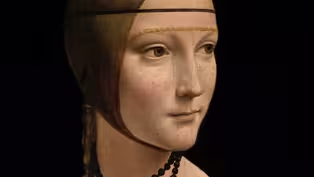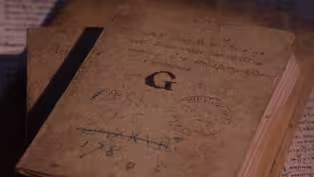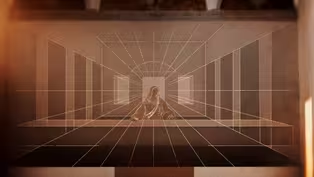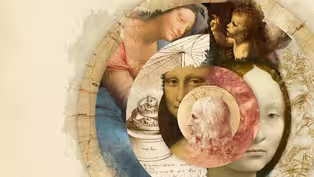
The Vitruvian Man and Leonardo da Vinci's Anatomical Studies
Clip: 11/18/2024 | 8m 2sVideo has Closed Captions
Leonardo da Vinci studied anatomy to gain a deeper knowledge of how the body worked.
Leonardo da Vinci believed extensive knowledge of human anatomy was essential to depicting the human form. Since medical teachings were inadequate, he began a meticulous study of his own – and he didn’t stop at the surface. He also drew muscles, bones and organs, and he experimented with different techniques. He even studied ancient sources, which led to his famous depiction of The Vitruvian Man.
Problems playing video? | Closed Captioning Feedback
Problems playing video? | Closed Captioning Feedback
Corporate funding for LEONARDO da VINCI was provided by Bank of America. Major funding was provided by the Corporation for Public Broadcasting, and by The Better Angels Society and by...

The Vitruvian Man and Leonardo da Vinci's Anatomical Studies
Clip: 11/18/2024 | 8m 2sVideo has Closed Captions
Leonardo da Vinci believed extensive knowledge of human anatomy was essential to depicting the human form. Since medical teachings were inadequate, he began a meticulous study of his own – and he didn’t stop at the surface. He also drew muscles, bones and organs, and he experimented with different techniques. He even studied ancient sources, which led to his famous depiction of The Vitruvian Man.
Problems playing video? | Closed Captioning Feedback
How to Watch Leonardo da Vinci
Leonardo da Vinci is available to stream on pbs.org and the free PBS App, available on iPhone, Apple TV, Android TV, Android smartphones, Amazon Fire TV, Amazon Fire Tablet, Roku, Samsung Smart TV, and Vizio.
Buy Now
Providing Support for PBS.org
Learn Moreabout PBS online sponsorship[Man exhales] Narrator: Like his old master Verrocchio, Leonardo believed that a deep knowledge of human anatomy was essential to depicting the human form, but he and his contemporaries were still dependent on the medical teachings of ancient physicians and philosophers whose centuries-old theories had mostly gone unchallenged.
Existing anatomical illustrations, which had been informed by those theories, were inaccurate and inadequate.
Man as Leonardo: A painter who learns about the nature of tendons, muscles, and sinews will know just how many and which tendons cause the movement of a limb or which muscle bulges and causes that tendon to contract.
Narrator: Leonardo drew muscles, bones, and organs and experimented with different techniques-- cross sections and transparency.
♪ Speaking Italian: Narrator: Now he obtained a skull and set out to map it in a series of drawings.
Kemp: He sectioned it horizontally and vertically.
You think, "Well, that's obvious," but it wasn't obvious.
Nobody did that.
There were no anatomical drawings in earlier books with sections of the skull, and he's looking at the skull empirically for its features, what it looks like, and wonderful, delicate drawings which are just awesome in terms of technique, and you think, "Well, he's doing the anatomy of the skull," but what he's really looking for is where the center of the brain is.
He talks about the pole of the cranium and that the point where all these proportional systems cross is where the senses all go into this central clearinghouse, as it were.
Those skull studies, which look like descriptive anatomy, are actually devoted to understanding the workings of the brain.
♪ Man as Leonardo: What sneezing is, what yawning is, sweating, fatigue, hunger, sleepiness, thirst, lust.
Narrator: Aristotle had believed that sensory impressions converged in a brain cavity, where they were processed, interpreted, and stored.
He called it the Sensus Communis.
Man as Leonardo: The soul seems to be located in the site of reason, and the site of reason seems to be where all the senses converge.
This is called the senso comune, and the soul is not all throughout and in every part of the body, as many previously believed, because if it were, it would not be necessary to have the instruments of the senses converge in a single location.
Narrator: To Leonardo, the transmission of information from the eye, which he called the window of the soul, to the brain and nervous system and the reaction that followed-- joy, fear, concern, surprise-- was the essence of the human experience.
Artists, he believed, should understand this phenomenon and the science behind it to effectively portray emotion, reveal character, and tell riveting stories.
Speaking Italian: Narrator: Leonardo saw proportion in the natural world as evidence of nature's matchless gift for design.
Using male models, he began a meticulous study.
Man as Leonardo: On the changing measurements of the human body through the movements of the limbs from different views, the measurements of the human body vary in each limb according to how much it is bent and from different views so that they grow or diminish to a varying extent on one side while they grow or diminish on the opposite side.
♪ Narrator: Seeking inspiration, Leonardo studied a treatise by Vitruvius, a Roman architect of the 1st century B.C., who wrote about the symmetry between the human body and a skillfully designed temple and carefully measured the proportions of what he described as a "well-shaped man."
Rossellini: And this was classical belief that the symmetry and proportion of the human body reflected as in a microcosm the greater harmony of the world.
Narrator: "Just as the human body yields a circular outline, so too a square figure may be found from it," wrote Vitruvius.
Borgo, speaking Italian: Man as Leonardo: The space between the parting of the lips and the base of the nose is 1/7 of the face.
Leonardo's very, very scientific about it.
Man as Leonardo: The space from the mouth to the bottom of the chin is 1/4 of the face... Isaacson: He does all sorts of measurements-- Man as Leonardo: in equal... Isaacson: from the forehead to the nose... Man as Leonardo: of the mouth... Isaacson: to the chin to the navel to the genitals of all of his assistants so he gets all the proportions exactly right, the way Vitruvius had suggested.
Man as Leonardo: The distance from the top of the nose, where the eyebrows begin, to the bottom of the chin is 2/3 of the face.
Borgo, speaking Italian: Del Toro: Leonardo is interested in the human proportion, and he thinks that's divine enough to be represented.
He says, "There is enough poetry "and enough cosmos and enough infinite "in another human being or a rock and a waterfall or a half-smile."
♪
Early Works of Leonardo da Vinci
Video has Closed Captions
Clip: 11/18/2024 | 8m 40s | Leonardo da Vinci’s first commissions are a great way to explore his early painting techniques. (8m 40s)
How Leonardo da Vinci Created Narratives in His Paintings
Video has Closed Captions
Clip: 11/18/2024 | 6m 37s | Leonardo da Vinci paints The Virgin on the Rocks and the portrait Lady with an Ermine. (6m 37s)
Video has Closed Captions
Clip: 11/18/2024 | 8m | Leonardo da Vinci’s notebooks provide unique insight into his mind, knowledge and discoveries. (8m)
Leonardo da Vinci’s The Last Supper
Video has Closed Captions
Clip: 11/18/2024 | 12m 8s | In the early 1490s, Leonardo da Vinci tackled his most ambitious work yet – The Last Supper. (12m 8s)
Video has Closed Captions
Preview: 11/18/2024 | 1m 10s | Explore one of humankind’s most curious and innovative minds. (1m 10s)
Providing Support for PBS.org
Learn Moreabout PBS online sponsorshipSupport for PBS provided by:
Corporate funding for LEONARDO da VINCI was provided by Bank of America. Major funding was provided by the Corporation for Public Broadcasting, and by The Better Angels Society and by...

